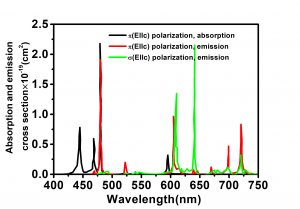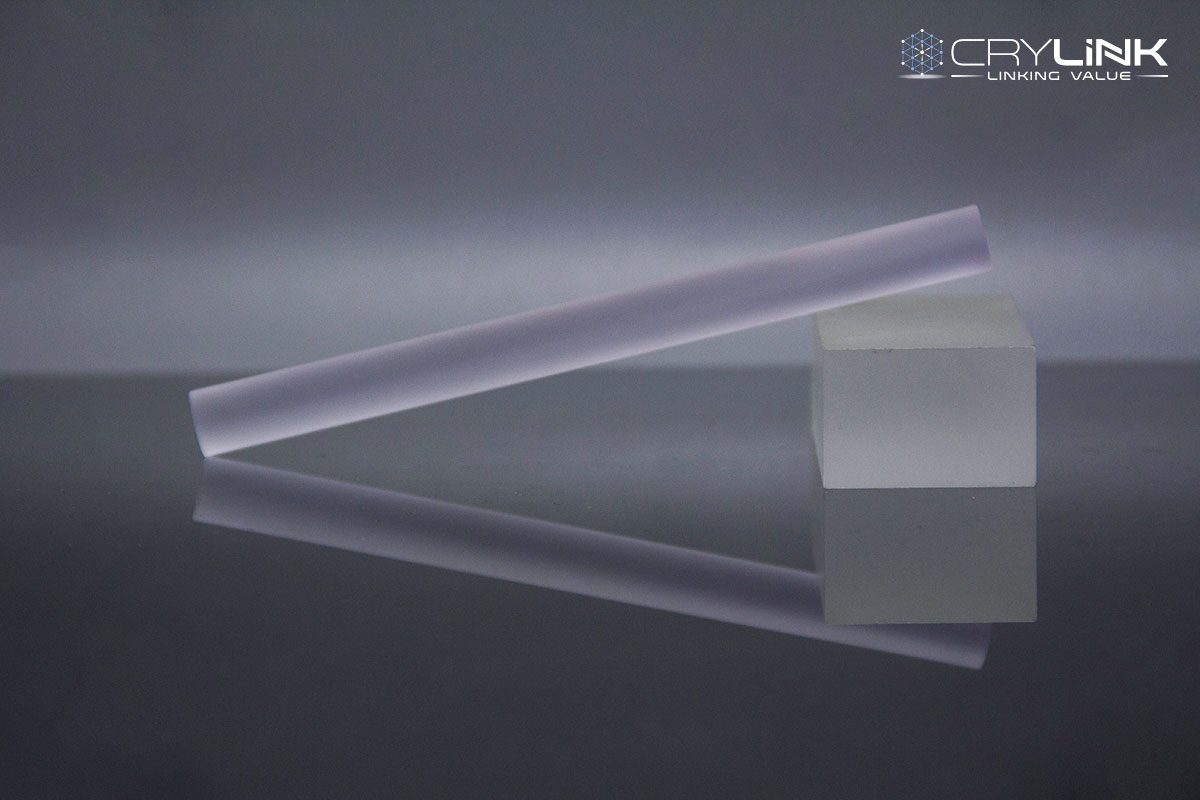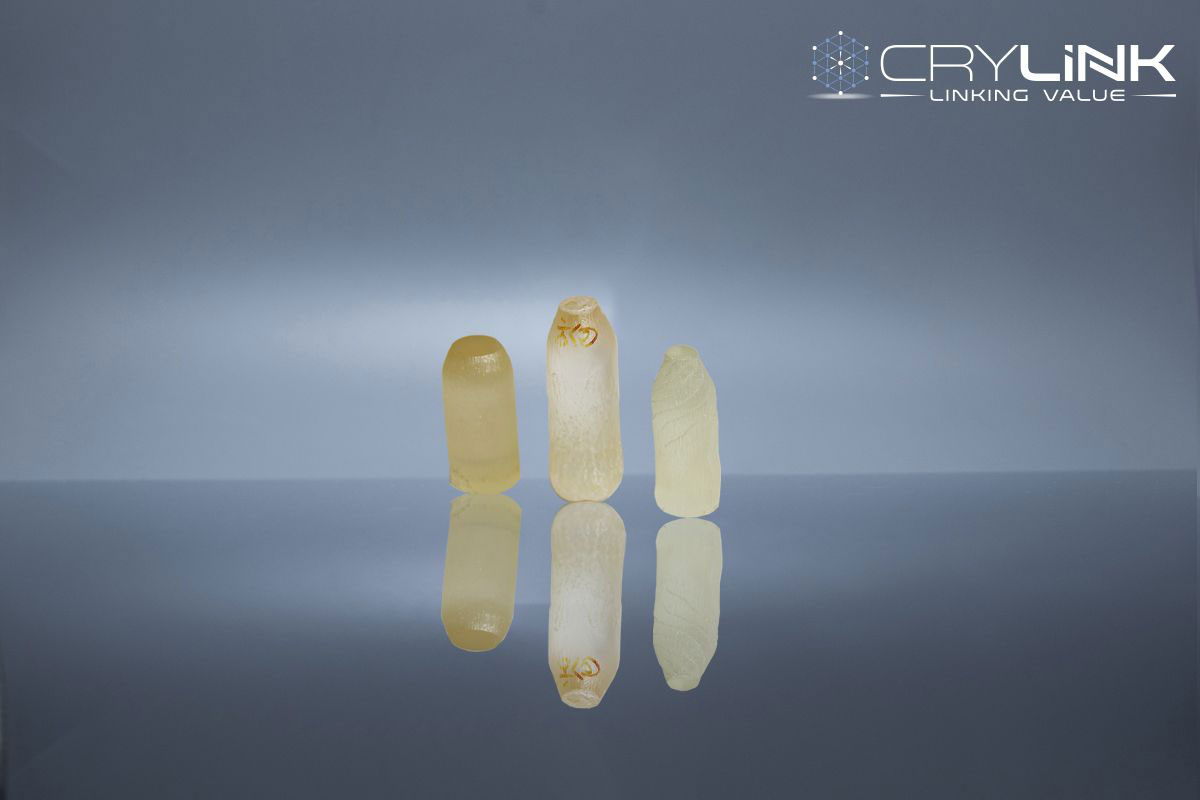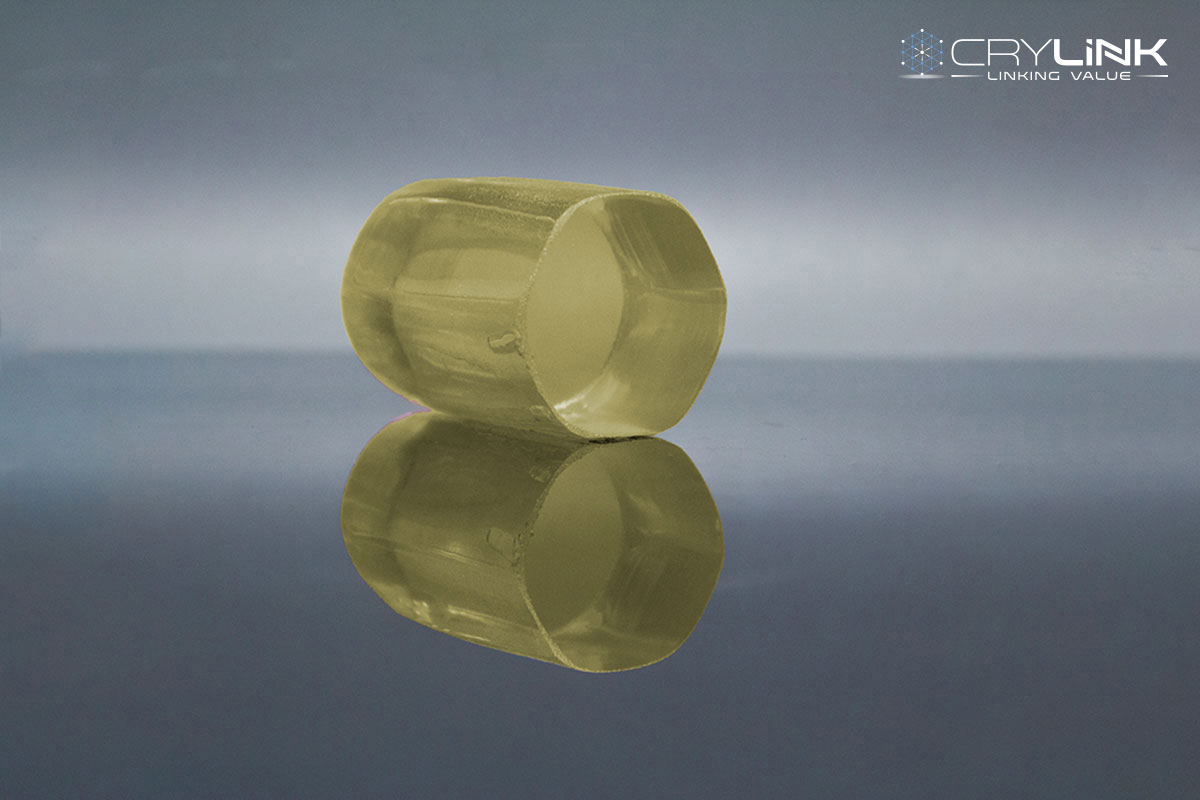Pr:YLF
Pr3+:YLF has been found as promising laser material for producing visible lasers directly. Many trivalent rare-earth ions (RE3) exhibit visible radiative transitions that potentially enable visibly emitting solid-state lasers. So far, various visible lasers based on RE3+-doped crystalline media have been demonstrated. Among them, trivalent praseodymium ion (Pr3) is recognized as one of the most successful active ions for achieving efficient visible lasers because the visible transitions of Pr3+ follow a four-level system, and their emission cross sections are larger than that of other RE3+. Many other RE3+ also exhibit visible transitions; however, these are often spin-forbidden, resulting in very small absorption and emission cross sections. Moreover, some visible transitions in RE3+ follow a three-level system, which is unattractive for laser demonstration. Only few laser materials have necessary properties for realization of lasing in visible spectral range. Trivalent praseodymium (Pr3+) is known to be an interesting laser ion for using with solid-state lasers in the visible spectral range because of its energy levels scheme, providing several transitions in the red (640 nm, 3P0 to 3F2), orange (607 nm, 3P0 to 3H6), green (523 nm, 3P0 to 3H5), and dark-red (720 nm, 3P0 3F3+3F4) spectral regions.
Parameter
| Orientation | a-cut |
| Parallelism | <10〞 |
| Perpendicularity | <10ˊ |
| Surface Quality | 10-5 S-D |
| Wavefront Distortion | <λ/4 per inch@632.8 nm |
| Surface Flatness | <λ/8 @632.8 nm |
| Clear Aperture | >90% |
| Face Dimensions Tolerance | +0/-0.1 mm |
| Length Tolerance | ±0.1mm |
| Chamfer | 0.1mm@45° |
| Coatings | R<1%@440-444nm+R<0.6%@500-700nm on both faces |
| Laser Induced Damage Threshold | >5J/cm2@532nm, 10ns |
| Structure Symmetry | Tetragonal |
| Lattice Constants | a=5.164, c=10.732 Å |
| Specific mass | 3.95g/cm3 |
| Melting Point | 819°C |
| Thermal Conductivity /(W·m-1·K-1) | 6 |
| Thermal Expansion /(10-6·K-1 ) | ~16 |
| Hardness ( @Mohs) | 5 |
| Typical Doping Level | 1@.% |
| Refractive Index (@1064nm) | no=1.448, ne=1.470 |
| Thermo-optic Coefficient(10-6·K-1) | -5.2(∥c), -7.6(∥a) |
| Lifetime of 3P0 Erbium Energy Level(μs) | 50 |
| Emission Cross-section(10-20/cm2) | 20×10-20cm2 |
| Absorption Peak Wavelength | 444nm |
| Absorption Cross-section at Peak | 8×10-20cm2 |
| Absorption Bandwidth at Peak Wavelength | ~5nm |
| Laser Wavelength | 640nm |
- High absorption and emission cross-sections(~10-19cm2)
- Good overlapping of the absorption band in the blue spectral region withthe emission
- Lines of the InGaN laser diodes and 2ω-OPSL
- Custom crystals available upon request
- Diode-pumped solid-state lasers for precise and efficient processing of metals such as copper or gold, entertainment industry and science
- Broadband laser mirrors
- Wavelength separators and combiners
- Polarizing cubes
| [1] Yz A , Lz A , Teng Z A , et al. Blue diode-pumped single-longitudinal-mode Pr:YLF lasers in orange spectral region – ScienceDirect[J]. Optics & Laser Technology, 130. |
| [2] Jin L , Dai W C , Yu Y J , et al. Single longitudinal mode Q-switched operation of Pr:YLF laser with pre-lase and Fabry–Perot etalon technology[J]. Optics & Laser Technology, 2020, 129:106294. |
| [3] Luo S , Cai Z , Sheng C , et al. 604-nm high-order vortex beams directly generated from a Pr:YLF laser with a cavity-loss-induced gain switching mechanism[J]. Optics & Laser Technology, 2020, 127. |
| [4] Luo, Saiyu, Yan, et al. Power scaling of blue-diode-pumped Pr:YLF lasers at 523.0, 604.1, 606.9, 639.4, 697.8 and 720.9 nm[J]. Optics Communications A Journal Devoted to the Rapid Publication of Short Contributions in the Field of Optics & Interaction of Light with Matter, 2016. |
| [5] Luo S , Cai Z , Xu H , et al. Direct oscillation at 640-nm in single longitudinal mode with a diode-pumped Pr:YLF solid-state laser[J]. Optics & Laser Technology, 2019, 116:112-116. |
| [6] Xu B , Liu Z , Xu H , et al. Highly efficient InGaN-LD-pumped bulk Pr:YLF orange laser at 607nm[J]. Optics Communications, 2013, 305(Complete):96-99. |
| [7] Xu B , Cheng Y , Qu B , et al. Power scaling of InGaN-LD-pumped Pr3+:LiYF4 Continuous-Wave deep red lasers at 697.6 and 695.8 nm[J]. Optics & Laser Technology, 2015, 67:146-149. |
| [8] Cui S , Xu B , Luo S , et al. Intracavity generated visible self-reconstructing Bessel-like laser beams by thermal effect[J]. Optics Communications, 2019, 458. |
| [9] Li Q S , Yuan D , Yu L , et al. Effect of cavity length on low-energy single longitudinal mode pre-lase Q-switched laser[J]. Optics & Laser Technology, 2017, 94:165-170. |
| [10] Wang J , Qi L , Zheng Q , et al. 430nm DPSS blue laser generated by sum-frequency mixing[J]. Optik, 2018, 170:233-236. |
| [11] Yongjie, Cheng, Jian, et al. Passive Q-switching of Pr:LiYF4 orange laser at 604 nm using topological insulators Bi2Se3 as saturable absorber[J]. Optics & Laser Technology, 2017. |
| [12] Walsh, Brian, M, et al. Mid-infrared spectroscopy of Pr-doped materials[J]. Journal of Luminescence: An Interdisciplinary Journal of Research on Excited State Processes in Condensed Matter, 2018, 197:349-353. |
| [13] Diode-pumped continuous-wave a- and c-cut Pr:Sr 0.5 La 0.5 Mg 0.5 Al 11.5 O 19 (Pr:ASL) visible lasers at 645 and 726nm[J]. Journal of Alloys and Compounds, 2019, 792:1200-1205. |
| [14] Qu B , Doualan J L , Xu B , et al. Detailed luminescence properties and laser potential of Pr:FAP[J]. Journal of Luminescence, 2016:402-407. |
| [15] Fujimoto Y , Nakanishi J , Yamada T , et al. Visible fiber lasers excited by GaN laser diodes[J]. Progress in Quantum Electronics, 2013, 37(4):185-214. |
| [16] Lin X , Zhu Y , Ji S , et al. Highly efficient LD-pumped 607 nm high-power CW Pr3+: YLF lasers[J]. Optics & Laser Technology, 2020, 129(1):106281. |
| [17] Kajikawa, Shota, Yoshida, et al. Visible Q-switched pulse laser oscillation in Pr-doped double-clad structured waterproof fluoride glass fiber with graphene[J]. Optics Communications: A Journal Devoted to the Rapid Publication of Short Contributions in the Field of Optics and Interaction of Light with Matter, 2018, 424:13-16. |
| [18] Zhou S , Pan Y , Li N , et al. Spectroscopy and diode-pumped laser operation of Pr:LaMgAl11O19 crystal[J]. Optical Materials, 2019, 89(MAR.):14-17. |
| [19] Zhang H , Wang J , Hasan T , et al. Photonics of 2D materials[J]. Optics Communications, 2018:S0030401817308994. |
| [20] Cai G X , Zhou M , Liu Z , et al. Spectroscopic analysis of Pr3+:Gd3Ga5O12 crystal as visible laser material[J]. Optical Materials, 2010, 33(2):191–195. |
| [21] 祖延雷, 张建秀, 傅佩珍, et al. Growth and optical properties of Pr~(3+):La_2CaB_(10)O_(19) crystal[J]. 中国稀土学报:英文版, 2009(6):911-914. |
| [22] Yu H , Qian X , Guo L , et al. Pr:Ca 1-x R x F 2+x (R=Y or Gd) crystals: Modulated blue, orange and red emission spectra with the proportion of R 3+ ions[J]. Optical Materials, 2018, 78:88-93. |
| [23] Soulard R , Xu B , Doualan J L , et al. Ground- and excited-state absorption and emission spectroscopy of Nd:GGG[J]. Journal of Luminescence, 2012, 132(10):2521-2524. |
| [24] Huber G , Heumann E , Sandrock T , et al. Up-conversion processes in laser crystals[J]. Journal of Luminescence, 1997, 72(96):1-3. |
| [25] Abramczyk H . Generation of Ultrashort Laser Pulses[J]. Introduction to Laser Spectroscopy, 2005:31-58. |
| [26] Pask H M , Dekker P , Mildren R P , et al. Wavelength-versatile visible and UV sources based on crystalline Raman lasers[J]. Progress in Quantum Electronics, 2008, 32(3-4):121-158. |
| [27] Few-layer Bi 2 Se 3 -based passively Q-switched Pr:YLF visible lasers |
| [28] Spatial anomalies in spectral-kinetic properties of Pr 3þ – Doped LiY 1-x Lu x F 4 mixed crystals |






Leave a Reply